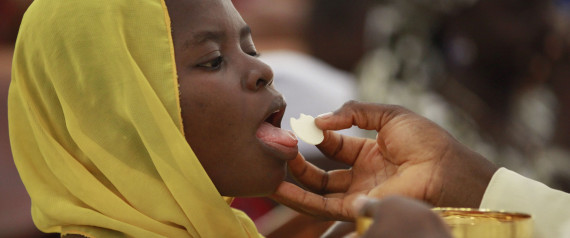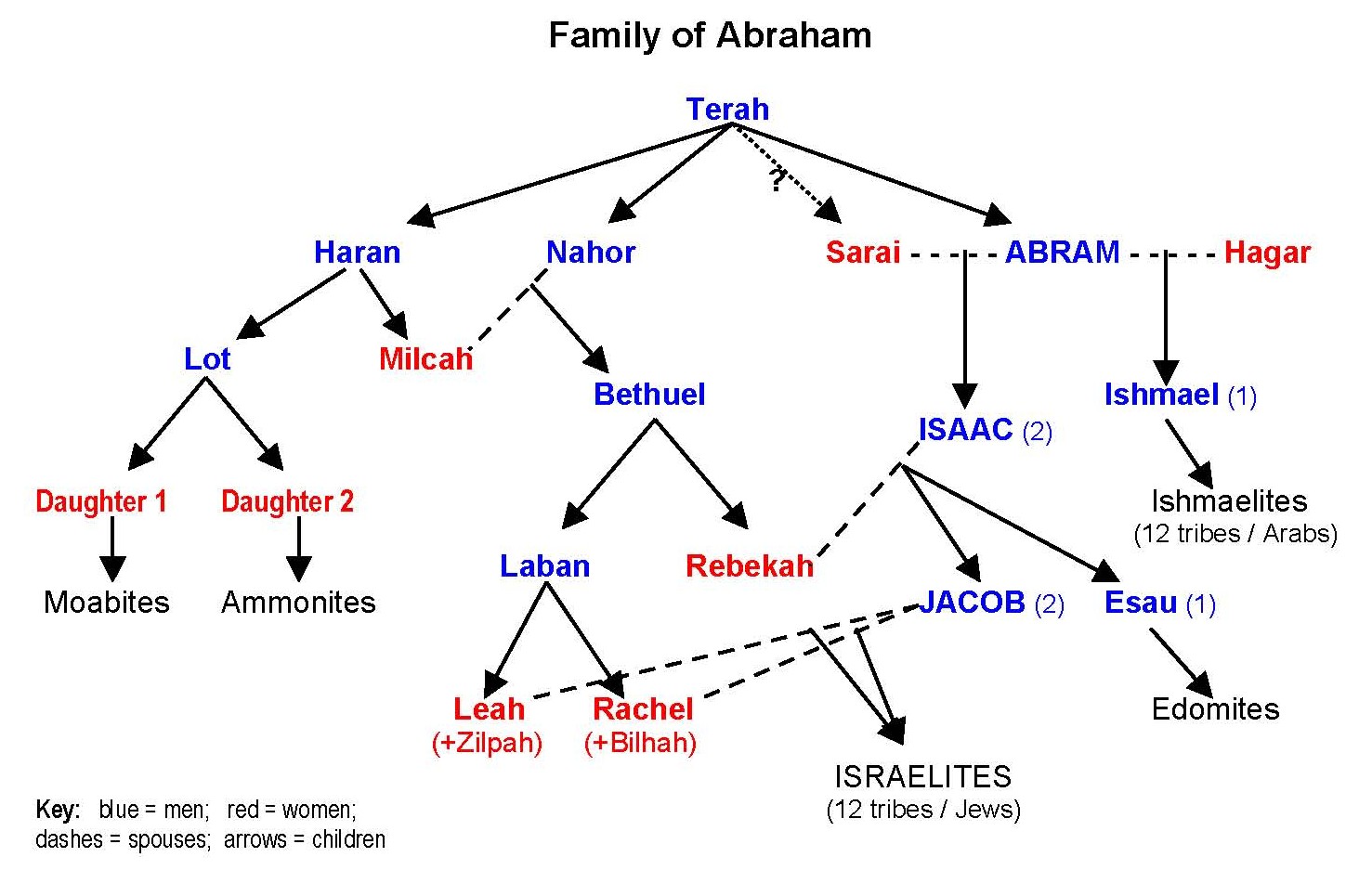by Felix Just, S.J., Ph.D.
Various biblical passages describe the complex inter-relationships in the family of Abraham (originally named Abram). Contrary to modern Western customs, it was acceptable in ancient times to marry close family relatives, including cousins and nieces. It was evidently also common for men to have more than one wife, and even to have children with women who were not their wives (slaves or concubines). For example, Abraham's first son was the child of his wife's slave-girl; and one biblical tradition even says that his wife, Sarah, was actually his half-sister. Similarly, the twelve sons of Jacob have four different mothers: the two wives of Jacob (who are his first cousins) and two other women (slave-girls of his wives).
A prominent feature of the biblical texts is also the explanation of tribal origins through various genealogies. Thus, the Israelites (the twelve tribes of Israel) see themselves as the descendents of the twelve sons of Jacob, son of Isaac, son of Abraham. In contrast, groups like the Ishmaelites and Edomites (to the south and southeast of the Israelites) are said to be descendents of Abraham's other children and grandchildren, while the neighboring Moabites and Ammonites (west of Israel) are described as descendents of Lot, Abraham's nephew.
Another important aspect of the biblical stories is what could be called family rivalries and disputes, esp. when younger sons usurp the inheritance rights of their older brothers. Thus, Abraham's inheritance is passed on to Isaac (not the first-born Ishmael), and then to Jacob (not his elder brother Esau).
Combining all the above points helps to explain both the close relationships and the bitter rivalries between the ancient Israelites and the neighboring Semitic peoples. The Israelites (and modern Jews!) believe that the promises God made to Abraham (esp. that his descendants shall possess the Promised Land forever) were legitimately handed on to them through Isaac and Jacob (as described in the Bible), while the descendents of the other tribes (and modern Arabs!) believe that the land should belong to them, since they are descendents of the elder sons (and thus the rightful heirs) of Abraham.
The following charts can help us visualize some of these complex relationships:
NOTES: (unless otherwise noted, all biblical references are from the Book of Genesis)
Terah: from Ur of the Chaldeans; has 3 sons; wife not named (11:26-32; cf. Luke 3:34).
Haran: dies in Ur before his father dies; wife not named; son Lot, daughters Milcah & Iscah (11:27-28).
Nahor: marries Milcah, daughter of his brother Haran (11:29); have 8 sons, incl. Bethuel (22:20-24).
Abram: main character of Gen 12-25; recipient of God's promises; name changed to ABRAHAM (17:5); sons Ishmael (by Hagar) and Isaac (by Sarah); after Sarah's death, takes another wife, Keturah, who has 6 sons (25:1-4), including Midian, ancestor of the Midianites (37:28-36).
Lot: son of Haran, thus nephew of Abram, who takes care of him (11:27-14:16; 18:17-19:29); wife and two daughters never named; widowed daughters sleep with their father and bear sons, who become ancestors of the Moabites and Ammonites (19:30-38).
Sarai: Abram's wife, thus Terah's daughter-in-law (11:29-31); Abram also calls her his "sister," which seems deceptive in one story (12:10-20); but in another story Abram insists she really is his half-sister (his father's daughter by another wife; 20:1-18); originally childless, but in old age has a son, Isaac (16:1-21:7); name changed to SARAH (17:15); dies and is buried in Hebron (23:1-20).
Hagar: Sarah's Egyptian slave-girl; mother of Abram's first son, Ishmael; much conflict with Sarah after his birth; even more after the birth of Sarah's son, Isaac (16:1-21:21).
Ishmael: first-born son of Abraham, by Hagar (16:1-17:27); wife or wives never named, but has 12 sons (25:12-16), the ancestors of 12 tribes of Ishmaelites (37:25-28).
Isaac: second son of Abraham, by wife Sarah, despite her old age (17:15-21; 21:1-35:29); marries Rebekah, who has twin sons, Esau & Jacob.
Betheul: youngest son of Nahor & Milcah; wife unnamed; father of Rebekah (22:23) and Laban (24:29).
Rebekah: daughter of Bethuel (22:23); becomes wife of Isaac (24:15-25:20); favors their younger son.
Laban: son of Bethuel, brother of Rebekah; has extensive interactions with Jacob (24:29-31:55).
Esau: elder twin son of Isaac & Rebekah (25:25); names of wives differ in two traditions (26:34 & 28:9 vs. 36:2-3); one is a daughter of Ishmael; his sons are ancestors of the Edomites (36:1-43).
Jacob: younger twin son of Isaac & Rebekah (25:26); conflicts with Esau (25:27-27:46); marries Leah and Rachel, daughters of his uncle Laban (27:43-29:30); name changed to ISRAEL (32:28); has 12 sons (with 2 wives + 2 slave-girls), ancestors of the Israelites or "12 Tribes of Israel" (29:31-49:33).
The Hebrew Bible describes the "Twelve Tribes of Israel" as descendents of the twelve sons of Jacob (also named Israel), with four different mothers. The births of the twelve sons (and the significance of their names) are described in chronological order in the book of Genesis (29:31–30:24 & 35:16-20). The Bible contains several different listings of the twelve tribes. Each tribe has its own characteristics and eventually obtains its own territory:
Reuben is the first-born son, and thus sometimes exercises a leadership role among this brothers; but he later loses favor and prominence.
The tribe of Joseph (through his sons Manasseh and Ephraim) becomes the largest and most prominent by the time the Israelites enter the Promised Land and divide it among themselves.
The tribe of Levi is uniquely important, not only because of Moses and Aaron, but since they become the priestly tribe (all the sons of Levi are priests, while members of any other tribe cannot be priests). The Levites do not receive a separate territory of their own, but rather live scattered among all the other tribes, where they serve as priests for the whole people.
Although the first king of Israel (Saul) is from the tribe of Benjamin, the tribe of Judah becomes known as the royal tribe, due to the promise God makes to King David that his descendents will rule over Israel forever (2 Sam 7).
Notes:
Jacob's twelve sons are first mentioned in the order of their births, in Genesis 29:31–30:24 & 35:16-20.
Leah (elder wife): 1) Reuben, 2) Simeon, 3) Levi, 4) Judah; later also 9) Issachar, 10) Zebulun
Bilhah (Rachel's slave): 5) Dan, 6) Naphtali
Zilpah (Leah's slave): 7) Gad, 8) Asher
Rachel (younger wife): 11) Joseph, 12) Benjamin
Manasseh & Ephraim – sons of Joseph, whose descendents figure prominently in the later history of Israel
Moses and Aaron – leaders of the Israelites at the time of their migration out of Egypt and wandering in the Sinai desert
Kings David & Solomon – the two greatest rulers of the united Kingdom of Israel, from about 1100 to 930 BCE
Tribe of Levi – becomes known as the “priestly tribe,” since all cultic & temple officials had to belong to this tribe
Tribe of Judah – becomes known as the “royal tribe,” since all later Kings of Judah were descendents of King David
See also my Overview of Israelite and Jewish History





6 comments:
Wow! What great charts. Thank you for the download, and all the information.
You are welcome, Sheila!
God bless you.
Michael Gormley
I enjoyed viewing your blog. Especially this chart here, under "the family of Abraham". There is so much good information here. May God bless you and yours.
God bless you, too, Sharing God's Love!
Good post and Smart Blog
Thanks for your good information and i hope to subscribe and visit my blog Ancient Egypt and more Djedefre's Pyramid thanks again admin
Thanks, Anonymous; I will certainly visit your BLOGS!
God bless you
Michael Gormley
Post a Comment